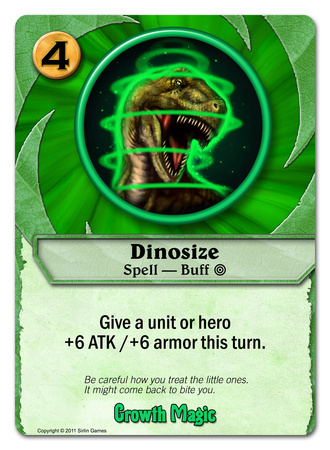Introduction
Codex is an intricate game that puts emphasize on anticipating which cards your opponent will play before (s)he does so. However, that requires you to know the options at his/her disposal. While Codex’s fixed card pool makes it easier to learn all cards, their sheer number can still be overwhelming to new players.
This guide is an attempt at showcasing important cards of every spec. A card may get highlighted for any of the following reasons:
- It has strengths (individually or in combos) that are not immediately obvious to a new player
- It is hard to react to if no preemptive measures have been taken
- It is a hard counter to certain strategies or punishes otherwise reasonable plays
- It is generally remarkably powerful for it’s tech level
- Codex has many strong cards and I am not going to list all of them
- I am talking about the type of cards that form the cornerstone of a spec’s strategy by sheer power
- Tech 3 cards and ultimate spells are expected to be strong and generally won’t be listed
- Hero cards are visible at all times and will not be featured unless they feature non-intuitive tricks
- The purpose of this thread would be lost if it were to feature too many cards
- I’ll use my own judgement regarding relevance and try to enforce a limit of three cards per spec
Basically, these are the cards you should know because they are either played a lot or a extra dangerous if you don’t know or understand them.
Disclaimer: I claim to be neither a good nor experienced player. I invite you all to discuss these lists. A lot of credit and thanks goes to everybody who helped me pick cards on Discord.
Quick navigation
- Green / Moss Sentinels
- Green Starter
- Balance
- Feral
- Growth
- Red / Blood Anarchs
- Red Starter
- Blood
- Anarchy
- Fire
- White / Whitestar Order
- White Starter
- Discipline
- Ninjutsu
- Strength
- Blue / Flagstone Dominion
- Blue Starter
- Truth
- Peace
- Law
- Purple / Vortoss Enclave
- Purple Starter
- Past
- Present
- Future
- Black / Blackhand Scourge
- Black Starter
- Demonology
- Necromancy
- Disease
- Brown / Neutral Renegades
- Brown Starter
- Finesse
- Bashing
Green / Moss Sentinels
[details=Green Starter]
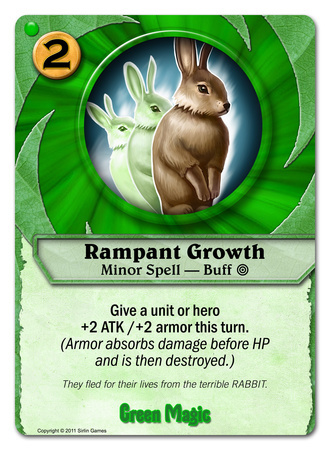
A relatively strong buff at a reasonable price that requires little setup. Beware![/details]
[details=Balance]

Not only is Tiny Basilisk the only t1 unit with deathtouch, its second ability has a strong synergy with the keyword, making it the perfect assassin on second cycle. And even when t0 units become rarer, it is rare for the Basilisk not to trade up.

The Balance dream is to get value out of a t0 or t1 unit (e.g. by killing one of your units with their unit barely surviving) and then transform it into an expensive t2 unit. This does not even require any tech buildings!
Green t2 units fill a variety of roles and Circle of Life helps its owner to make the most of it by instantly picking the right tool for job. Even discounting the other green specs, Balance might summon a flyer that turns other units into flyers or kills damaged units, a potent defender (pardon) that doubles as upgrade/spell removal, or this guy:
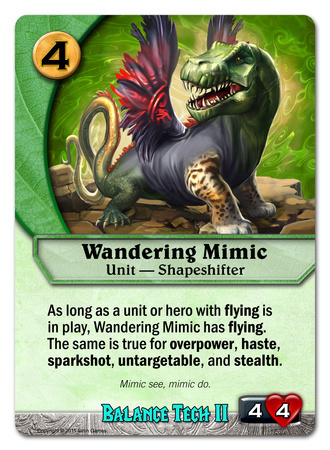
A common strategy for Balance is to buff its go-to combat unit by playing a diverse variety of units. You can keep a Wandering Mimic’s power in check by taking out the cogs in the machine. Maybe even more importantly, beware what abilities you give it with your own units.[/details]
[details=Feral]
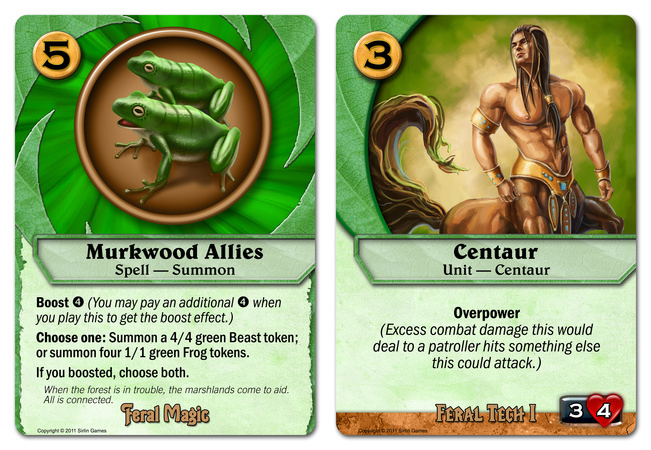
If somebody uses Feral in their Codex, chances are (s)he’s going to use one of these in their second cycle. Centaur is a big, cost-efficient unit that can put its overpower keyword to good use, especially combined with buffs from green starter or the Growth spec. Murkwood Allies’ frog option does not require a tech building and can be hard to deal with unprepared. Taking out all of them is hard, likely leaving the Feral player with buff targets next turn. The frogs also synergize with the following card.
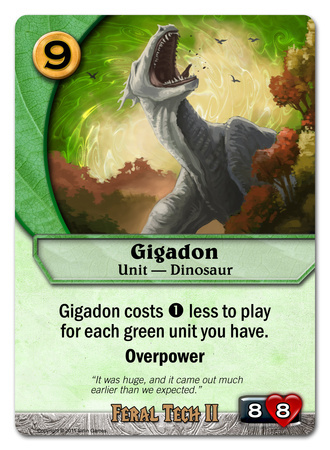
Feral has solid, but generally not outstanding t2 options. Gigadon can be an exception if the board state makes is sufficiently inexpensive. If your opponent built a Feral t2, they have teched Gigadon more likely than not. From now on, taking out green units just got worth 1 extra gold!

Another reason not to let a feral player build a board. Giving all of one’s units swift strike is obviously very powerful and can turn an even board into a blow-out. Note that the effect remainings throughout your turn as well, potentially turning a single high-attack patroller into an unsurmountable wall.[/details]

Unconditional, targeted removal is hard to come by in Codex. This card is not exactly removal but it is close enough. Note that it can target non-patrolers and t3 units. While it is not permanent, a 1/1 is easy to deal with and even if the Growth player cannot take it out, it remains a 1/1 during your turn as well.
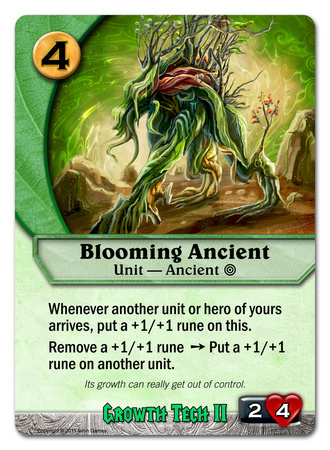
This unit can quickly grow out of control. Unlike a similiar card, Blooming Ancient generates runes off tokens and therefore synergizes with Argargar’s hero card, the green panda units, and off-spec token cards.[/details]
Red / Blood Anarchs
[details=Red Starter]

Half of the red starter involves instantaneous damage. Charge is the least card-efficient of those options but it scales decently as the game continues.

Notable for being THE Codex meme. ![]() [/details]
[/details]
[details=Blood]
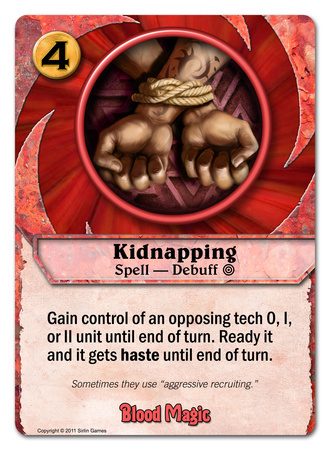
Kidnapping is a scary spell. If you don’t consider it when patrolling, it might end up killing two units (or one unit and hero each) by itself. But even at less than full potential it will usually effectively sideline a patroller and give the caster some extra damage to work with. Considering the red gameplan is usually a base race, this considerable extra reach is important to respect.
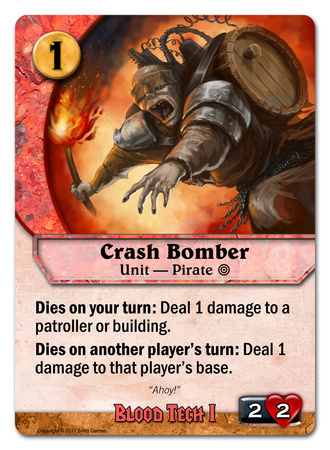
Just on their own, Crash Bombers represent unavoidable base damage. Taking into account the crazy kill reach of Blood’s t2 options, every point of damage matters. Will often be used by aggro players who have found themselves at too much of economic disadvantage and need to cash in patrol zone bonuses while still advancing their goal.
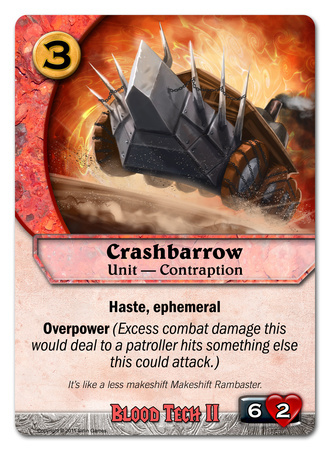
Crashbarrow could be compared to 3-gold 6-damage nuke. It must target patrollers first but otherwise has few targeting restriction. It can also split its damage across two targets! Helps breaking through patrolers or finishing the game.
Forms a very strong multicolor combo with the black starter card Graveyard.[/details]
[details=Anarchy]
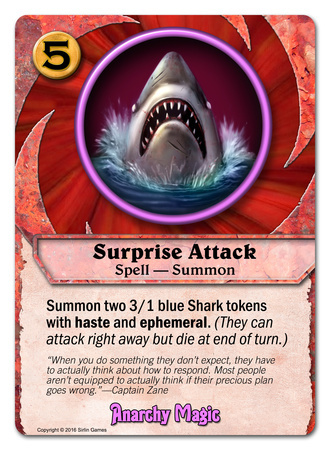
A more expensive, less-flexible Crashbarrow that doesn’t require a Tech 2 Building. Serves the same purpose in the end game but comes online earlier and will therefore often be used for trades. Set up your patrol zone and board in a way that doesn’t leave a bunch of 3-life things ripe for the taking. Couple with Zane’s own haste, sharks can deal a lot of surprise damage in the endgame with just a single card.

These two cards serve a very similiar purpose. One costs less gold, one costs less cards and can be replayed next turn. Anarchy’s theme is instant surprise damage. While its other cards have to deal with the patrol zone, these two stealth around it. Consider building a tower when your opponent locks ANarachy as their t2 spec.
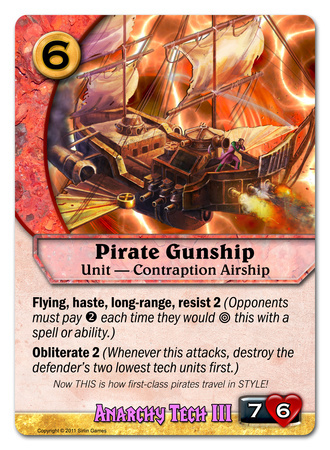
Generally agreed to be the strongest t3 card in the game. It is relatively cheap, haste, and the stats and abilities to usually win the game the turn it hits the board. And even if your opponent survives the turn, the ship will probably have killed three of its things just by itself. Obliterate on a haste card is hard to overrate! [/details]
[details=Fire]

All of Jaina’s spells are targeted damage spells. While the other non-ultimates are cheaper or more powerful, Ember Sparks is the most flexible one.

The cheapest t1 haste unit. Also arguably the best of the many “2/2 with a bonus for 1 gold” t1s. Haste is powerful in Codex.
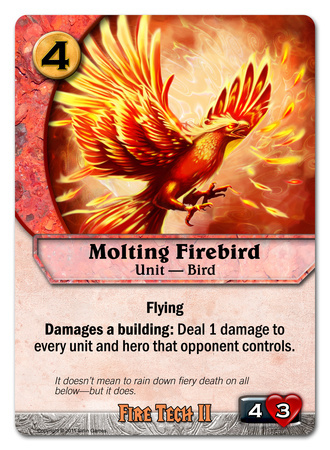
A destructive card on its own, Molting Firebird combos well with the many red (though technically not Fire) ways to give units haste and +1 atk. WIth the help of Charge or Drakk, it one-shots tech buildings on top of wreaking havoc on the board on the turn it arrives.[/details]
White / Whitestar Order
[details=White Starter]
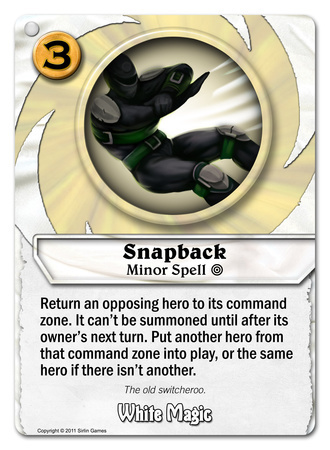
Snapback not only makes it hard to keep your leveled heroes on the board, it can also pull heroes from your command zone to subsequently be killed and blocked from casting spells in your next turn. Also, remember that it effectively sidelines a patrolling hero.[/details]
[details=Discipline]

YLDs do not look like much but they are an above-average flying unit. 5 damage is a magic number for one-shotting tech buildings and max-level heroes and YLDs can even reach 6. Also offer a lot of reach for closing out a game.
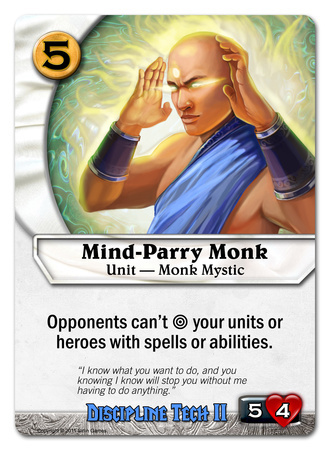
Mind-Parry Monk wrecks strategies that rely on targeting spells or abilities. Often the reason to build a Discipline Tech 2.[/details]
[details=Ninjutsu]
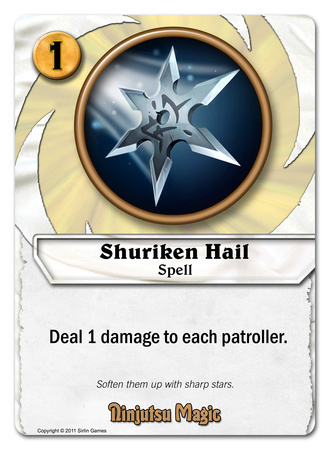
As a general rule, Setsuki’s spells revolve around surprise damage and I’m not going to list them all. A notable examle is Shuriken Hail because it is somewhat specific in what it counters: You don’t want to use (many) 1-health patrollers against Ninjutsu.
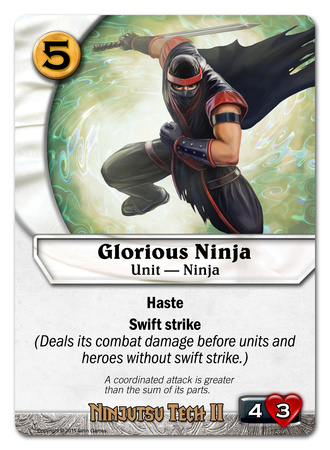
Already a powerful card with immediate impact, Glorious Ninja benefits from a variety of tribal effects. Excpect this to get stealth or invisibility at some point. Also, be sure to have a way around on of them patroling as an Elite.
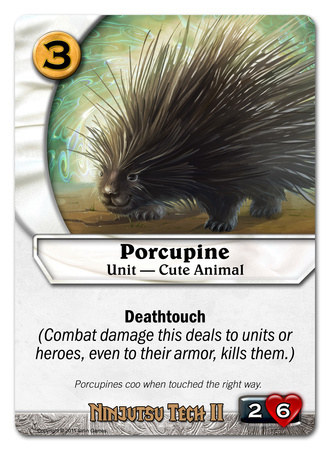
One of the most cost-efficient blockers in the game. Expect to see this or be forced into bad trades. Fox’s Den School can turn it into a potent assassin.[/details]
[details=Strength]
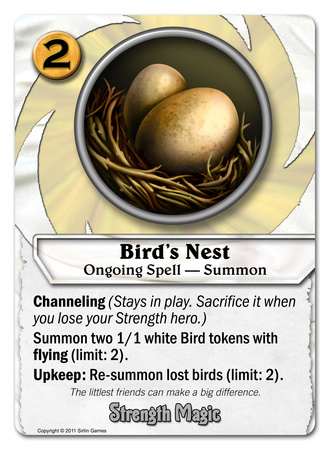
Early access to 2 (seperate!) flying damage is a strong benefit. Note that birds already on the table do not die when Rook or the spell leave play. It also combos well with the white minor spell Sensei’s Advice. The card is a very common early tech and you should think about a counter as early as your first tech. A tower can help in a pinch.
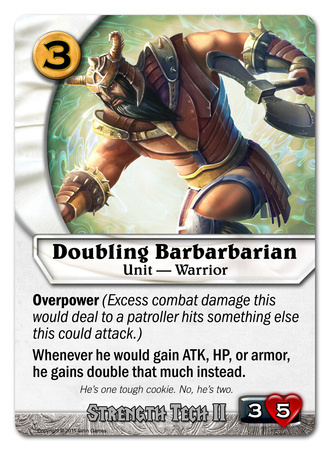
A decent card in a vacuum, this obviously synergizes with a lot of buffs and some multicolor teams can threaten absolutely crazy Barbarbarians (lol). You’ll want to prevent these combos.
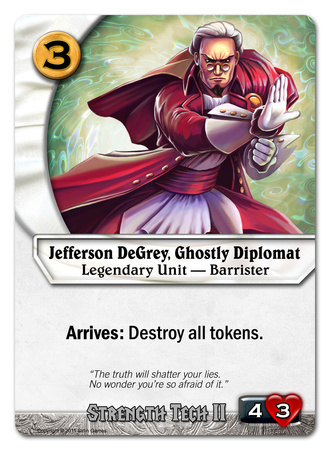
Not exactly a power card, you should think twice about playing token-based strategies against Strength, especially if your opponent already has Mythmaking in play.[/details]
Blue / Flagstone Dominion
[details=Blue Starter]
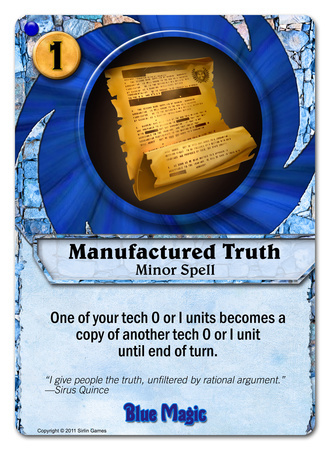
This can turn one of your opponent’s units into a stronger one. (duh!)
Be aware that this can copy your units, so be mindful of what you play. More commonly, this is generally used to transform a turn1 unit into…
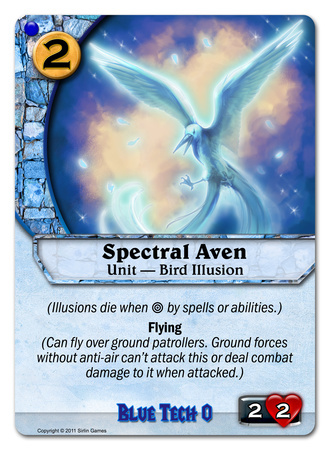
… a t0 2/2 flyer. Spectral Aven would be useful even without the possibility to turn other units into copies of it. Luckily, it’s also an illusion. You’ll want some way to target it even if it is not patrolling, or quickly find another method of dealing with it.[/details]
[details=Truth]
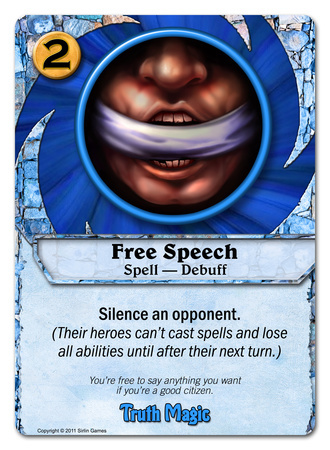
Aside form the obvious effects, this is one of the very few methods to prevent heroes in the command zone to cast a spell next turn.
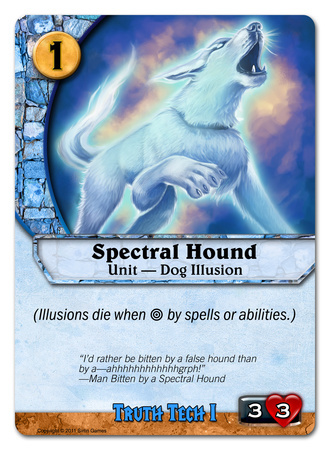
Being an illusion is a notable weakness, but you will be hard-pressed to find a more cost-efficient unit at t1. This is also preview of what’s to come at t2. If you don’t integrate tools that kill illusions by targeting, your opponent will likely out-value you. That being said…
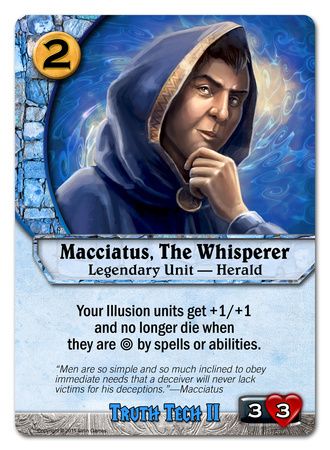
…Macciatus removes all illusions’ major weakness. Don’t rest on the fact that you’ve specced all those targeted spells and abilities if you can’t deal with him.[/details]
[details=Peace]
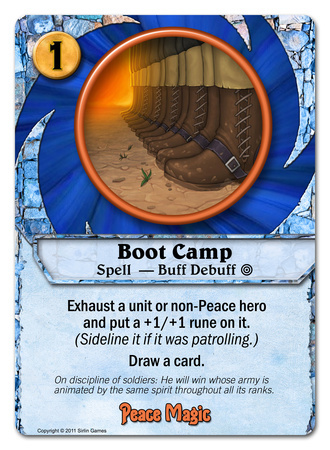
A deceptively flexible and powerful card. At the cost of just 1 gold and 0 cards, it can buff the Peace player’s cards (note that it can be cast on exhausted units) and can sideline almost any patroller, including t3 units and even heroes.
A strong card during all phases of the game, it replaces itself for 1 gold at worst.
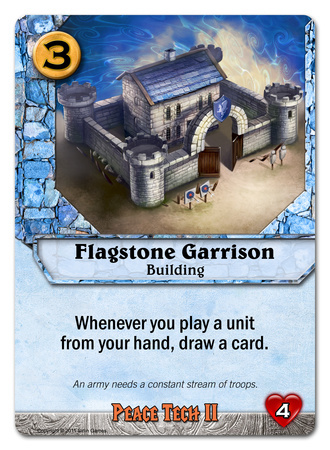
Cards for days! Combo this with a deck of cheap units like the in-faction Overeager Cadet for immense card advantage and cycling speed. Forms the cookie-cutter Peace combo with…
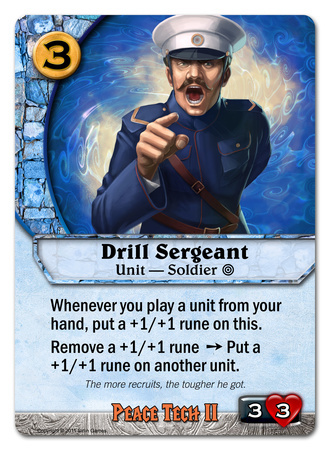
If a mass of weak units doesn’t cut it, you can beef them up with this guy. With a Garrison in place, Drill Seargeants rack up runes quickly and can coordinate devastating attacks. Note that they can transfer runes on the turn they’ve arrived. Also note that they can attack with a bunch of runes before transferring them to another unit that has yet to attack.[/details]
[details=Law]

Bigby is adept at dealing with large numbers of units. You are generally well-adviced to put more emphasize on heroes and spells than usual. In addition, try not to rely too much on one tech-tier of units to avoid getting blown out by Injuction for cheap.
Judgment Day combos with Censorship Council, making it harder for you to recover.
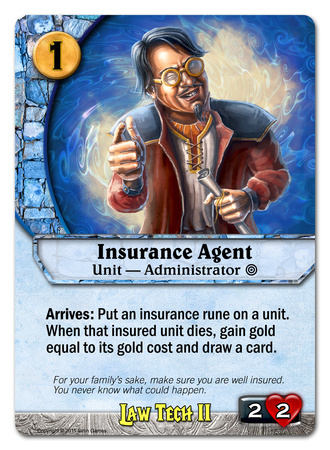
Insurance Agents can generate a huge material advantage for their controler if you are not aware of them. They will generally target a thing that is going to die this turn anyway. Considering they only cost 1, they easily make up for their own cost. But if you let them target an expensive unit of yours, the swing in gold can easily be overwhelming.
Side note: Community Service is another reason not to mindlessly tech big units against Law.

Law’s combat unit is an expensive powerhouse. An unstoppable units with those stats is a large threat and its two lives almost guarantees that it will trade up. The two lives also make it so that it can survive a Judgment day![/details]
Purple / Vortoss Enclave
[details=Purple Starter]

The cornerstone of purple’s early game. Mox can put a severe damper on most kinds of offense and also threaten free kills. Some multicolor codexes aim to boost it with +1/+1 runes (which are not discarded on “death”) and use it in place of t2 units. The most popular spec for that is Peace with Boot Camp and Flagstone Garrison as an impactful non-unit t2 option.

Not only is Nullcraft one of the rare flying t0 units, it also has haste, effectively turning it into an (expensive) burn spell that forces (expensive) responses from most opponents or will keep hitting things every turn.[/details]
[details=Past]

Don’t rely on your heroes as patrollers and don’t dump too much gold into them unless you can get some immediate value out of it.

A strong tempo card on 2nd cycle and often the first t1 card teched. Expect it to bounce a patroller and don’t play expensive t0 units unless you expect to trade with them before turn 3.
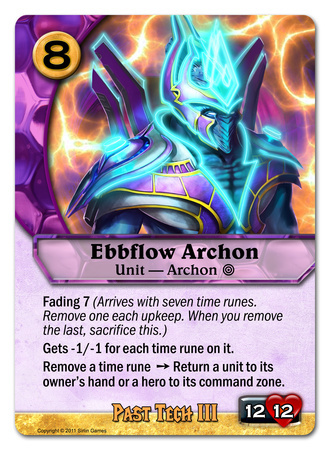
An exceptionally strong and immediate t3 unit. Might as well have worse stats and read, “Arrives: bounce all enemy heroes and units”
If you absolutely cannot prevent this from hitting the table in time, relying on untargetable/invisible units may be your best bet.[/details]
[details=Present]

THE reason to play Present. Haste is always powerful in Codex and its second ability makes this great tempo card also generate a big card advantage. Note that Hyperions reach the magic number of 5 attack with Battle Suits in play.

Tricycloid is effectively a 3/3 that deals 1 damage three times on arrival. It’s worse than e.g. Bamstamper Lizzo numbers-wise but it is a lot more flexible.
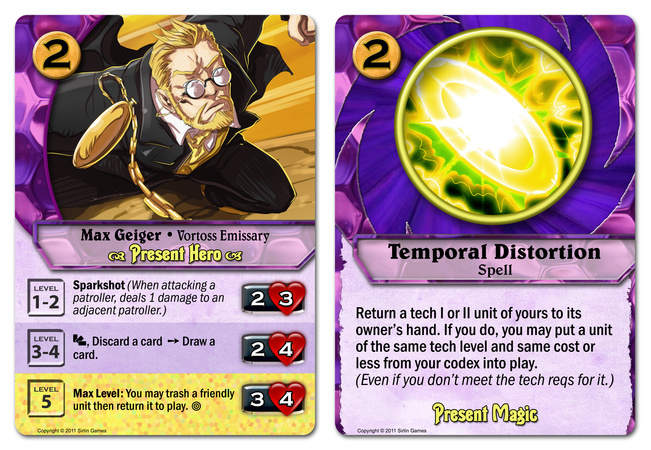
Another reason why the 2 previous cards are so good is their synergy with effects that bounces and replays units.
You can play a Hyperion, use it to kill something and then use Geiger’s max-band or Temporal Distortion to heal it and attack again (and draw another card!).
With Tricycloid, you are effectively dealing 3 additional damage.
In monopurple, Prynn’s max-band can serve the same purpose in a pinch.[/details]
[details=Future]
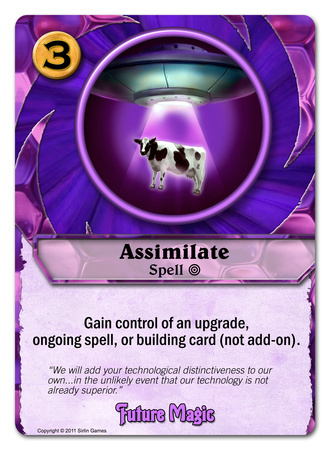
Assimilate is the only card in Codex that can steal control of non-unit cards. Considering how hard it is to destroy upgrades, the stealing might as well be permanent. Don’t rely on stealable cards against Future.

A strong body that pays for its insane gold efficiency with Forecast 3. Decent in any deck that can survive a couple turns, it really shines in combination with time rune manipulation (e.g. Tinkerer).
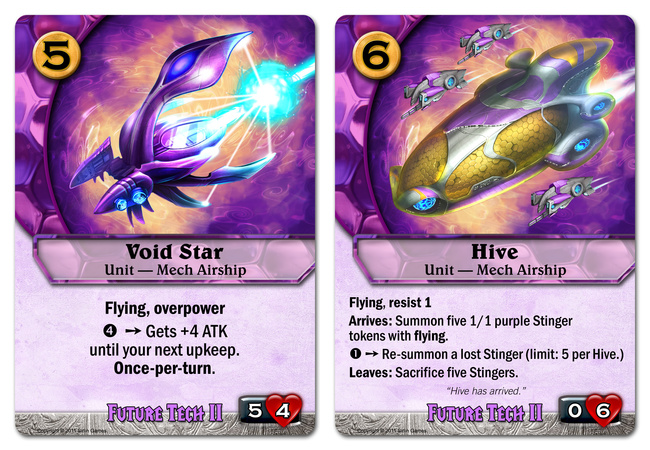
Future features two of -if not THE- the strongest t2 flyers. While expensive, its hard to argue against their raw power.[/details]
Black / Blackhand Scourge
[details=Black Starter]
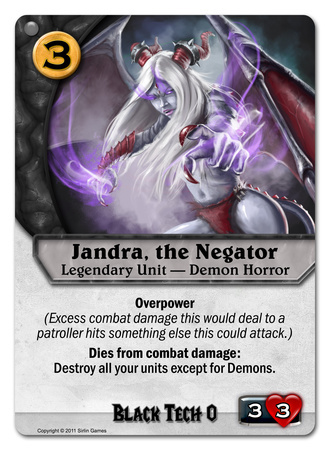
Jandra is arguably the single most powerful t0 unit in the game (at least in a vacuum). 3/3 already puts her ahead of everything else and Overpower makes very good use of her great stats. Her drawback can be significant but can also be played around.
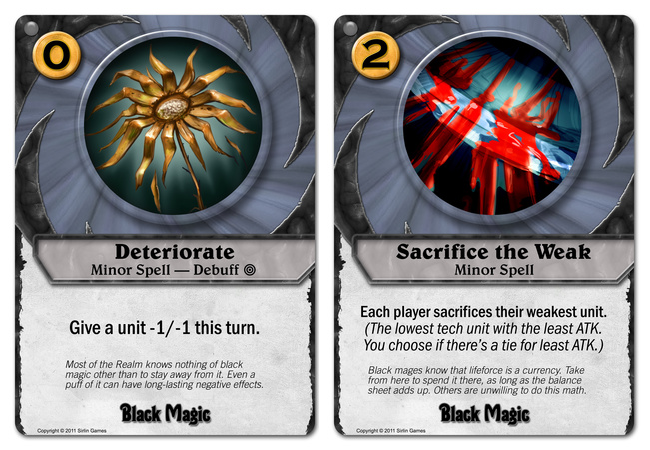
Having both these cards in the same deck puts a lot of risk on the opponent. As black’s opponent, you can neither play weak units nor expensive ones without risk. Note that Deteriorate will kill 1-HP squad leaders.[/details]
[details=Demonology]
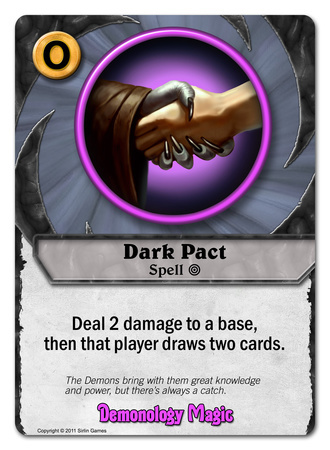
Pot of Greed isn’t banned in Yu-Gi-Oh for no reason. Tradin one card for two at no (economical cost) is as good as it sounds. The base damage can become significant in a base race but Vandy’s goal is to use her card advantage to prevent you getting that far.
Teching 2 of these on turn 2 gives her very good odds of drawing her entire 2nd-cycle deck and the cards she’d just teched in turn 3.

Getting to cast Metamorphosis does not necessarily mean an instant win in the mid game (unlike many other ultimates) but it creates a big advantage during any stage of the game. A common, if not THE Demonology strategy is to build a Heroes’ Hall and threaten Metamorphosis ASAP, sometimes even before building a t1 building. Vandy being cheap to max as well as her midband ability make this strategy require little commitment for a very serious threat.

Terras has absolutely ridiculous stats with a potentially fatal drawback: He can’t do anything unless its owner manages to kill four 0/1 tokens.
Intra-spec, Demonology can combo it with Banefire Golem and black has further options in Disease. Deckbuilding gives rise to better combos though, most famously, Finesse’s Discord.[/details]
[details=Necromancy]
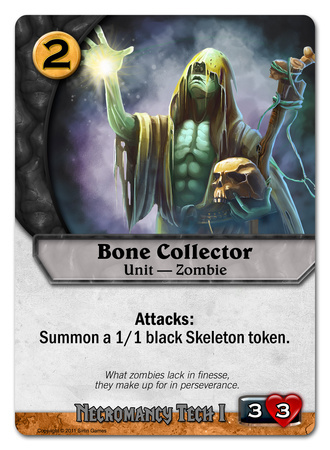
Bone Collector follows the usual curve of 3/3 t1 units with an ability for 2 gold, but what an ability it is! Leaving an patroller after attacking would be decent enough, but Necromancy/black also has a few tribal effects for Skeletons, like Skeletal Lord, Skeletal Archery and even Garth’s hero card.
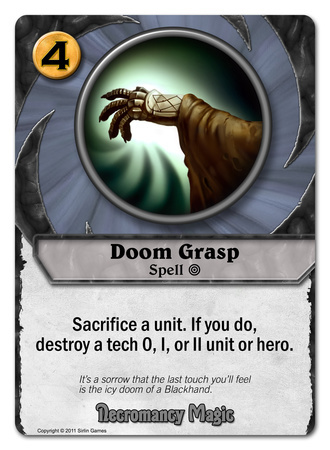
One of Codex’s very few targeted, (almost) unconditional removals. It is very expensive, but reliable and a strong deterrent for enemies to play big units or plan any kinds of ultimate-reliant strategies. Another good Necromancy removal is Hooded Executioner.
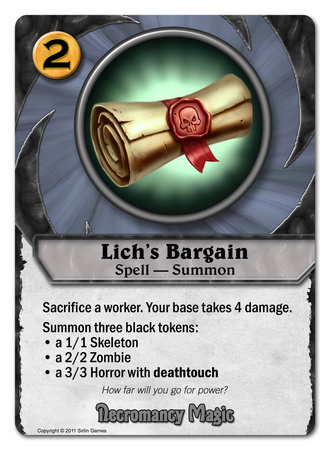
Casting this early is a big tempo play but sacrificing a worker can snowball into a considerable economical disadvantage and delay tech buildings. Be sure to be prepared for this spell so that it doesn’t pay off for the Necromancy player.[/details]
<a name="disease"></a><b>Disease</b>

Plague Lab amplifies Disease’s -1/-1 rune strategy, but it also helps kickstart it if things didn’t go well for its owner early on. Comboed with Spreading Plague, it can clear your whole board without prior setup.

I hope you weren’t going for any spell-based strategies or even combos. Not only does Carrion Curse generate card advantage, it is the only targeted discard effect in the game.

Gorgons are almost guaranteed to generate card advantage by trading with whatever fights them and then replacing the card used to play them. Their moderate defense also means that they probably won’t trade down in gold cost.
Brown / Neutral Renegades
[details=Brown Starter]

A peculiar starter card because it can target non-patrollers. You may want to level up that 1 health hero now instead of next turn.

Tenderfoot has the highest health among all 1-gold starter cards which is a very noticeable advantage. It also has the Virtuose sub-type, which has heavy tribal synergy in the Finesse spec.[/details]
[details=Finesse]

This card would be good if it just had haste itself. The most comparable t1 unit is Lobber which is cheaper (and has a minor ability) but considerably less durable. Add to that that it gives other Virtuoses haste, including the already strong Tenderfoot, and you get one of the best t1 units.

This amazing buff would be hard to set up if it wasn’t for Finesse’s potent haste units. It’s still not trivial to use but the pay-off is usually immense. A popular combo with early flying options like Gargoyle and Bird’s Nest.

Finesse is all about offense with small units. Discord allows them to fight your big patrollers and survive. It also kills all low-tech 1 hp units, making it a popular counter to token-based strategies and the cheapest option for unshackling Terras Q.[/details]
<a name="bashing"></a><b>Bashing</b>

Intimidate turns most trades into free kills. Note that it can affect heroes and t3 units.

Most of Bashing’s units are inferior versions of other specs’ units, but their unique combination and neutral nature are worth considering when building your codex.
Iron Man is “slightly worse than Centaur” which basically means it is still really good. Note that it is not strictly inferior because it combos with Midori’s mid-band).

This is a worse but still great version of Bamstamper Lizzo, but its relative value is higher in a spec that does not already have easy access to direct damage.
